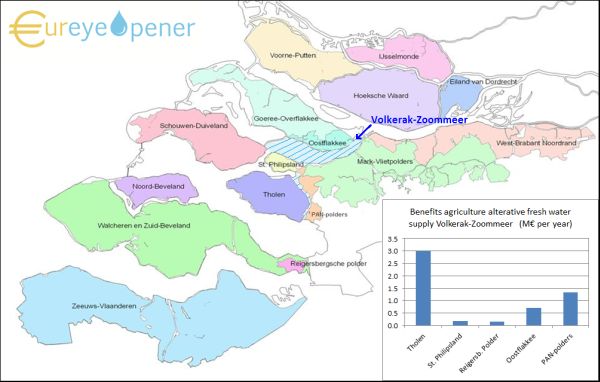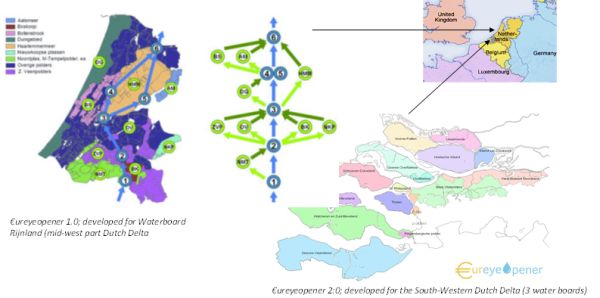€ureyeopener for freshwater management
Purpose of the tool
The €ureyeopener is a agro-hydrological model for decision support in freshwater management. The model calculates the fresh water demand in a Delta or river basin, the related yields of crops (in kg and euro’s) and the economic response (costs and benefits) of water management measures. The purpose is to gain quick insight in the routing and efficiency of the fresh water supply system and to find sustainable solutions to improve the hydrological and economic response of deltas that are (or will become) under pressure of drought and salinization.
Target group
Water managers on a regional and national scale, policy makers for agriculture, water, environment, and spatial planning, representatives from agriculture.
Tool description
The model calculates the water and salt balance of the surface waters by combining hydrological data of drainage and seepage patterns in the river basin. The water demand for irrigation and the stress of agriculture crops from drought and salt is calculated with the SWAP model for the representative soil profiles. The results of these calculations are used as metadata in the €ureyeopener. Working with the pre-processed input data speeds up the calculations which enables the use of the tool in an interactive or group setting. In 5-20 seconds the model calculates the water demand and yields for several decades on a summer half year or monthly basis. Adaptation measures are incorporated in the model in a pragmatic way by simple analytical functions or extra SWAP-calculations. The results of the €ureyeopener are not only expressed in amounts of water and crop yields, but all scenarios are also expressed in financial costs and benefits.
Result description
In the Dutch south-western delta, the national government considers to change the water management of Lake Volkerak-Zoom and turn it into a salt lake again. In several parts of the delta agriculture depends on the fresh water supply from the lake, so this salty policy scenario is combined with an alternative fresh water supply system. The €ureyeopener was applied to calculate the benefits of this alternative fresh water supply. The results are summarized in the table below.

The benefits of the alternative water supply are more than 5 million euros per year. This is because a) the water quality of the alternative supply is better than the current water from Lake Volkerak Zoom, b) the supply is secured during the whole growing season instead of the current situation where the supply stops in august because of algae bloom in Lake Volkerak Zoom) and c) it is assumed that farmers will switch to more capital-intensive crops (fruits and vegetables) because the farmers can irrigate with more freshwater and have more security of this supply.

The colours on the map of the Dutch southwestern delta show the hydrological units for which the water- en salt balance was calculated. Drought and salt stress and irrigation demands are calculated within these units on a spatial scale of 100 x 100 m. The graph shows how the alternative water supply for the lake Volkerak affects the five hydrological units that presently depend on fresh water from the lake (Tholen, St. Philipsland, Reigersbergsche polder, PAN-polders, Oostflakkee).
The tool in practice
The €ureyeopener is applied in the mid-western and the south-western delta of the Netherlands.

Necessary inputs and conditions
The model needs hydrological data (precipitation, evapotranspiration, drainage and seepage fluxes, chloride concentrations or EC of drainage, seepage and inlet water), land use, crops, soil type and soil moisture characteristics.
Contact data
Alterra, Wageningen UR.
- Lodewijk Stuyt +31 317 486428 lodewijk.stuyt(at)wur.nl
- Peter Schipper +31 317 484997 p.schipper(at)wur.nl
Phase and tool category: Strategy Development and Planning | Economic tool
Spatial scale and time scale
- River basin districts, delta’s
- Modelling period of several decades, calculations on a half yearly, monthly or weekly basis
Tool availability
A tailor made application is needed for each delta / river basin. The €ureyeopener will also be developed for the Northern part of the Dutch Delta (Waterboard Hollands Noorderkwartier). We are looking for cases to apply the model in other deltas that have to cope with (increasing) droughts in summers and salinization.
Downloads
- Alterra report 2510: Schipper, P.N.M., G.M.C.M. Janssen, N.B.P. Polman, V.G.M. Linderhof, P.J.T. van Bakel, H.T.L. Massop, R.A.L. Kselik, G.H.P. Oude Essink & L.C.P.M. Stuyt; €ureyeopener 2.1: Zoetwatervoorziening Zuidwestelijke Delta en Rijnmond-Drechtsteden; gepubliceerd: 01 May 2014; 70 pp.
- Alterra report 2511: Schipper, P.N.M., G.M.C.M. Janssen, N.B.P. Polman, V.G.M. Linderhof, P.J.T. van Bakel, H.M. Massop, R.A.L. Kselik en L.C.P.M. Stuyt; Effect zout Volkerak-Zoommeer op de zoetwatervoorziening van de landbouw; Berekening droogte- en zoutschade met €ureyeopener 2.1 voor Tholen, St. Philipsland, Oostflakkee, Reigersbergsche en PAN-polders; gepubliceerd: 28 Apr 2013; 42 pp.
- Alterra report 2439: L.C.P.M. Stuyt, P.J.T. van Bakel, J. Delsman, H.T.L. Massop, R.A.L. Kselik, M.P.C.P. Paulissen, G.H.P. Oude Essink, M. Hoogvliet en P.N.M. Schipper; Zoetwatervoorziening in het Hoogheemraadschap Rijnland; onderzoek met hulp van €ureyeopener 1.0; gepubliceerd: 17 Jul 2013; 90 pp
- SWAP model